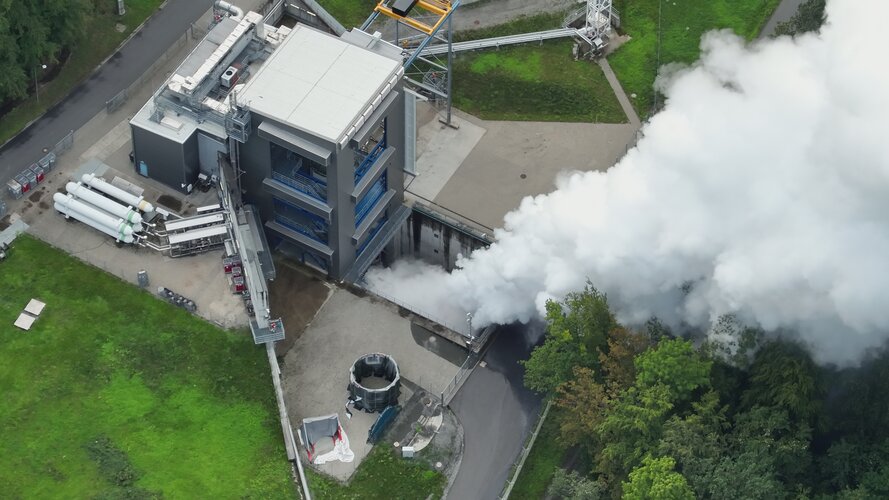
Copernical Team
Pentagon unveils new website for reporting (and learning about) UFOs

The Pentagon has opened up a new portal for professionals to submit reports about UFOs—now officially known as unidentified anomalous phenomena, or UAPs—and for the rest of us to find out about the reports that have been released.
AARO.mil, the website for the All-domain Anomaly Resolution Office, is still a work in progress. For example, a promised online form for contacting the AARO is labeled as "Coming Soon." But the version unveiled today offers eight videos showing UAPs, plus archives for congressional reports and briefings, press releases and links to other resources.
"The website will serve as a one-stop shop for all publicly available information related to AARO and UAP," Air Force Brig. Gen. Pat Ryder, the Department of Defense's press secretary, said today during a briefing.
Trial by fire for Ariane 6’s upper stage

Validation testing continues for ESA’s all-new Ariane 6 launch vehicle, with firing of its two upper stage engines to simulate the way they will have to operate together during a flight.
Week in images: 28 August - 01 September 2023

Week in images: 28 August - 01 September 2023
Discover our week through the lens
Hera asteroid mission here
 Image:
Hera asteroid mission here
Image:
Hera asteroid mission here Thermometer molecule confirmed on exoplanet WASP-31b
 Chromium hydride (CrH), a molecule that's relatively rare and particularly sensitive to temperature, is useful as a "thermometer for stars," according to astronomer Laura Flagg, because it's abundant only in a narrow range between 1,200-2,000 degrees Kelvin.
Flagg, a research associate in astronomy in the College of Arts and Sciences (A&S), has used this and other metal hydrides to determi
Chromium hydride (CrH), a molecule that's relatively rare and particularly sensitive to temperature, is useful as a "thermometer for stars," according to astronomer Laura Flagg, because it's abundant only in a narrow range between 1,200-2,000 degrees Kelvin.
Flagg, a research associate in astronomy in the College of Arts and Sciences (A&S), has used this and other metal hydrides to determi Newly discovered planet has longest orbit yet detected by the TESS mission
 Of the more than 5,000 planets known to exist beyond our solar system, most orbit their stars at surprisingly close range. More than 80 percent of confirmed exoplanets have orbits shorter than 50 days, placing these toasty worlds at least twice as close to their star as Mercury is to our sun - and some, even closer than that.
Astronomers are starting to get a general picture of these plane
Of the more than 5,000 planets known to exist beyond our solar system, most orbit their stars at surprisingly close range. More than 80 percent of confirmed exoplanets have orbits shorter than 50 days, placing these toasty worlds at least twice as close to their star as Mercury is to our sun - and some, even closer than that.
Astronomers are starting to get a general picture of these plane LRO data helping NASA prepare for Artemis astronauts on the Moon
 When astronauts set off for a trip around the Moon in 2024 with NASA's Artemis II mission, they will go primed with knowledge of lunar landmarks gathered by one of the Agency's premiere robotic missions to our nearest cosmic neighbor. NASA's Lunar Reconnaissance Orbiter (LRO), launched in 2009, has returned a treasure trove of scientific data in its fourteen years of operation, but this is not a
When astronauts set off for a trip around the Moon in 2024 with NASA's Artemis II mission, they will go primed with knowledge of lunar landmarks gathered by one of the Agency's premiere robotic missions to our nearest cosmic neighbor. NASA's Lunar Reconnaissance Orbiter (LRO), launched in 2009, has returned a treasure trove of scientific data in its fourteen years of operation, but this is not a Photocatalytic CO2 conversion for artificial carbon cycle at extraterrestrial sites
 Today, space missions mainly rely on the transportation of basic needs from the Earth, which is extremely challenging and logistically impossible when we aim to develop stations or habitats on extraterrestrial sites such as the Moon and Mars.
For example, an astronaut needs almost a kilogram of oxygen per day to sustain their life. Therefore, tons of oxygen have to be transported to build
Today, space missions mainly rely on the transportation of basic needs from the Earth, which is extremely challenging and logistically impossible when we aim to develop stations or habitats on extraterrestrial sites such as the Moon and Mars.
For example, an astronaut needs almost a kilogram of oxygen per day to sustain their life. Therefore, tons of oxygen have to be transported to build SwRI will lead Hubble, Webb observations of Io, Jupiter's volcanic moon
 The Space Telescope Science Institute recently awarded Southwest Research Institute a large project to use the Hubble and James Webb telescopes to remotely study Io, the most volcanically active body in the solar system. The study will complement the upcoming flybys of the Jupiter moon by NASA's Juno spacecraft and will provide insights into Io's contributions to the plasma environment around Ju
The Space Telescope Science Institute recently awarded Southwest Research Institute a large project to use the Hubble and James Webb telescopes to remotely study Io, the most volcanically active body in the solar system. The study will complement the upcoming flybys of the Jupiter moon by NASA's Juno spacecraft and will provide insights into Io's contributions to the plasma environment around Ju Infospectrum expands Spire Global contract to enhance vessel-tracking capabilities
 Infospectrum has expanded its agreement with Spire Global, Inc. (NYSE: SPIR) is seto to acquire historical vessel-tracking data in addition to port event information.
The maritime analytics market is expected to be over $2 billion by 2028. Spire's historical automatic identification system (AIS) data and Port Events solution - which supplies live and historical vessel arrival and departure
Infospectrum has expanded its agreement with Spire Global, Inc. (NYSE: SPIR) is seto to acquire historical vessel-tracking data in addition to port event information.
The maritime analytics market is expected to be over $2 billion by 2028. Spire's historical automatic identification system (AIS) data and Port Events solution - which supplies live and historical vessel arrival and departure 